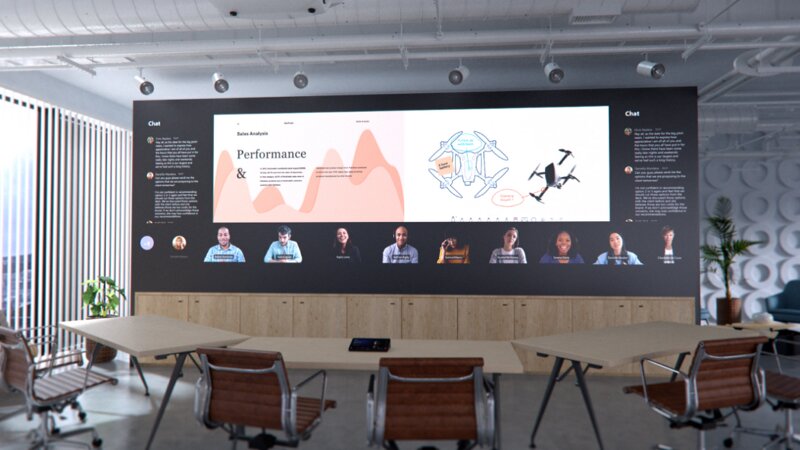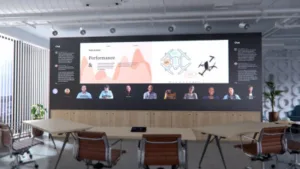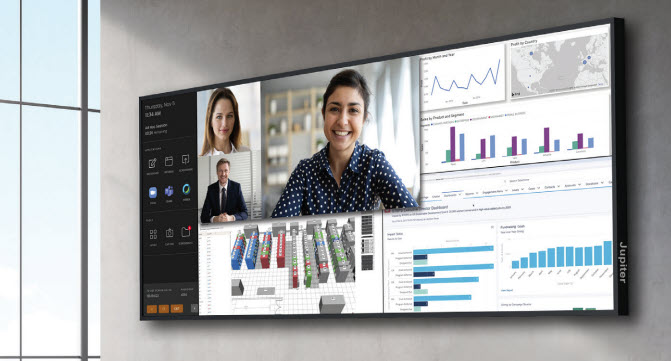In yesterday’s Display Daily, I mentioned that the Invidis Yearbook had alerted me to an interesting development by Microsoft. The firm has included a new arrangement for Teams displays called Front Row that is optimally viewed in 21:9 format. It got me thinking about that shape of display.

 Front Row is a special layout for Teams
Front Row is a special layout for Teams
While the CRT industry made CRTs that were the most economically efficient aspect ratio of 4:3 or later in 16:9 to match widescreen formats, the aspect ratio of LCDs is much more free form. I guess there is probably an optimum cost ratio of column/source drivers to glass area, but until you get to relative extremes, most shapes can be made. More important is how many panels of a particular shape can be cut from the big substrates. 16:9 became the mainstream from G6 panel fabs starting a long time ago and since then, fabs have been generally optimised around that aspect ratio.
For panel makers, in general, because panels are ‘sold by the diagonal inch’, but because costs are broadly based on area, if you can describe a panel with a bigger diagonal number, but the same area, there has always been an incentive for panel makers to like them. (for example, a 34″ 21:9 monitor uses 4% less glass than a 32″ 16:9). But whether they make sense depends on the application.
- Projection – showing Cinemascope images in 21:9 makes a lot of sense, so projection systems that include curtains or masks for different aspect ratios seems like a good idea. Digital projectors have pretty well always recognised this.
- Notebooks – in 1996, Sharp launched its Widenote notebook which had a 15:9 display and in 2012 Toshiba actually launched a Satellite notebook with 21:9. I tried the Toshiba Widenote (which was 1024 x 600) and always liked that it made it easier to use on economy flight seats, but in recent years the trend has been towards taller notebook displays, rather than wider, e.g. 3:2 aspect (13.5:9)
- TV LCD panel and set makers really promoted the idea of 21:9 sets for TV from around 2009, but by 2012, the idea was dropped. I never thought it made sense and wrote an article in 2011 (21:9 – Bah! Humbug!) that summarised why it didn’t and it seemed I wasn’t too wrong. The arguments still apply.
- Monitor makers started with the format around 2012 with a 29″ panel from LG Display, if I remember correctly. In monitors, I always thought 21:9 and wider formats made sense and I summarised a lot of the logic in two articles at the end of last year. (The Shape of (Monitor) Things to Come (Part 1))
- Smartphones have adopted wider formats as makers tried to get more display area while still fitting in the user’s hand. The shape of rigid smartphones seems to have settled now, although foldables and rollables will offer a lot of flexibility in coming years.
That brings us to ‘large format displays’. They are typically used either in public display applications, where 21:9 might be a reasonable option. However, volumes of public displays are relatively small compared to TVs, so usually it makes sense to use an LCD cell based on a TV size and shape to get the most economic set.
That brings us to the interactive display. It seems to me that 21:9 makes a lot of sense in this application. Once you stick a display on the wall and you have to interact with it, you really don’t want the top of the display to be too high. Holding a hand above the head for any length of time is uncomfortable and displays need to be accessible to a wide range of users with different heights. In a lot of cases, interactive displays will be installed in pairs to create a 32:9 format, but that can complicate things.
The only real challenge to developing the 21:9 aspect ratio is the same as the challenge for public displays – the economy of scale for 16:9 given by the TV industry is really significant and I didn’t think there were any volume 21:9 panels being made in sizes below 105″ (and at 105″, there are several, but while they might be in ‘mass production’, high volume is not likely to be accurate).
Microsoft recommends a resolution of ‘5K’ which would make the optimum resolution 5120 x 2160 giving a 21:9 version of an UltraHD/4K 16:9 panel.
Last year Jupiter Systems, Inc launched a 105″ 21:9 monitor and in digging around for this article, I found that the firm also lists an 81″ version with both being available with or without touch. Jupiter has been in the interactive and collaboration display field for a long time and we reported in 2015 that the firm had been acquired by InFocus, by then itself a part of the Foxconn empire. It showed the 105″ at ISE and Infocomm this year.
As well as working with Microsoft, Jupiter has worked with the Valerea product team which is a software solution for collaboration and that has now been optimised for 21:9. There is a video here.
Invidis reports that Sharp NEC Display Solutions also showed a 21:9 format display at ISE, but in the case of that firm, it was based on direct view LED rather than LCD. LEDs, of course, even the ‘monolithic’ designs made for easy ‘Plug & Play’ are made from modules, so building a 21:9 format is really not a challenge. The challenge with LED is the pricing! (BR)


